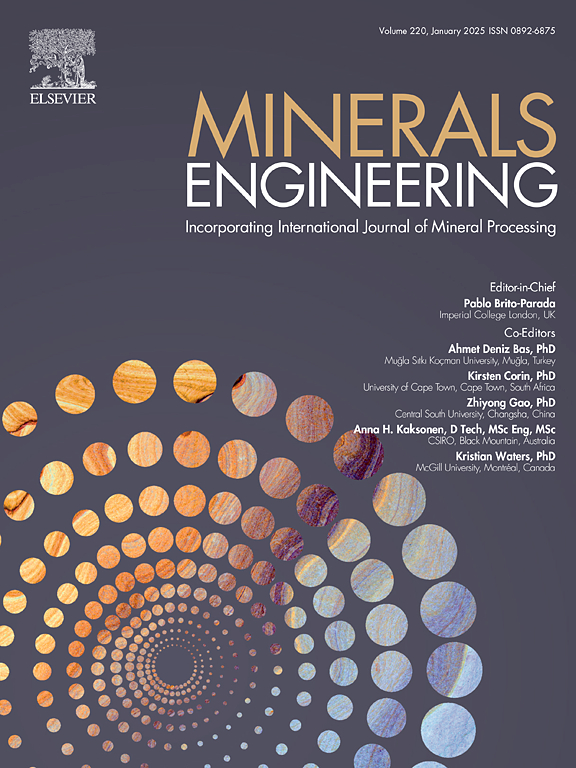Influence of process variables on the operational capacity of an industrial vibrating screening
IF 4.9
2区 工程技术
Q1 ENGINEERING, CHEMICAL
引用次数: 0
Abstract
This study examines the key parameters influencing solid–liquid separation on an industrial vibrating screen. A screen with a 74 µm opening was employed to separate a suspension of sand particles (mean Sauter diameter of 288 µm) dispersed in a water phase containing smectite clay thickener. The independent variables investigated included screen inclination, feed flow rate, and vibration intensity (g-force). The responses evaluated were the moisture content of retained solids, the progression of the region predominantly occupied by the liquid phase (referred to as the pool region), and the level of the pool region on the screen. The results indicated that increasing g-force, increasing screen inclination, and reducing the feed flow rate contributed to a decrease in the advancement of the pool region. Regarding the pool region level, a reduction was observed with higher g-force, lower screen inclination, and decreased feed flow rate. For the moisture content of the retained solids, an increase was observed with higher feed flow rates. However, the effects of screen inclination and g-force on moisture content were opposing, as their interaction influenced the observed experimental outcomes. These effects were associated with the operational capacity of the vibrating screen, which demonstrated sufficient processing capability for up to 96 % screen occupancy by the pool region. Additionally, a linear relationship was observed between the advancement of the pool region and its level at constant screen inclination values.

工艺变量对工业振动筛运行能力的影响
研究了影响工业振动筛固液分离的关键参数。采用开口为74 μ m的筛网分离分散在含有蒙脱石粘土增稠剂的水相中的沙颗粒悬浮液(平均直径为288 μ m)。自变量包括筛管倾角、进料流量和振动强度(重力)。评估的响应是保留固体的水分含量,主要由液相占据的区域(称为池区域)的进展,以及屏幕上池区域的水平。结果表明,增大重力、增大筛网倾斜度和减小进料流量均可减小池区推进。在池区水平上,随着重力增大、筛网倾角减小和进料流量减小,可以观察到减少的现象。对于保留固体的水分含量,观察到随着进料流量的增加而增加。然而,筛网倾角和重力对含水率的影响是相反的,因为它们的相互作用影响了观察到的实验结果。这些影响与振动筛的运行能力有关,振动筛显示出足够的处理能力,高达96%的筛网占用池区域。此外,在恒定的筛斜值下,观察到池区域的推进与其水平之间存在线性关系。
本文章由计算机程序翻译,如有差异,请以英文原文为准。
求助全文
约1分钟内获得全文
求助全文
来源期刊

Minerals Engineering
工程技术-工程:化工
CiteScore
8.70
自引率
18.80%
发文量
519
审稿时长
81 days
期刊介绍:
The purpose of the journal is to provide for the rapid publication of topical papers featuring the latest developments in the allied fields of mineral processing and extractive metallurgy. Its wide ranging coverage of research and practical (operating) topics includes physical separation methods, such as comminution, flotation concentration and dewatering, chemical methods such as bio-, hydro-, and electro-metallurgy, analytical techniques, process control, simulation and instrumentation, and mineralogical aspects of processing. Environmental issues, particularly those pertaining to sustainable development, will also be strongly covered.
 求助内容:
求助内容: 应助结果提醒方式:
应助结果提醒方式:


